Contribute $100 to our fundraising campaign and RECEIVE the book of your choice from the list below personally signed by the author!
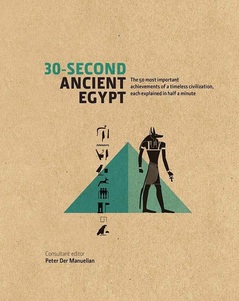
Just added!
30-Second Ancient Egypt:
The 50 most important achievements of a timeless civilization, each explained in half a minute
Edited by Peter Der Manuelian
Signed by Harvard Egyptologists Peter Manuelian (editor), Nicholas Picardo (contributor), and Rachel Aronin (contributor)
30-Second Ancient Egypt:
The 50 most important achievements of a timeless civilization, each explained in half a minute
Edited by Peter Der Manuelian
Signed by Harvard Egyptologists Peter Manuelian (editor), Nicholas Picardo (contributor), and Rachel Aronin (contributor)
We’ve all heard of pyramids, hieroglyphs and Cleopatra, but how much do you really know about ancient Egypt? Why was the Nile integral to the unification of Egypt? What is the mystery surrounding Queen Hetepheres’ tomb? What did the Amarna Letters reveal? What did the ancient Egyptians eat and drink?
30-Second Ancient Egypt presents a unique insight into one of the most brilliant and beguiling civilizations, where technological innovations and architectural wonders emerge among mysterious gods and burial rites. Each entry is summarized in just 30 seconds using nothing more than two pages, 300 words and a single picture. From royal dynasties and Tutankhamun’s tomb, to hieroglyphs and mummification, interspersed with biographies of Egypt’s most intriguing rulers, this is the quickest path to understanding the 50 key ideas and innovations that developed and defined one of the world’s great civilizations.
30-Second Ancient Egypt presents a unique insight into one of the most brilliant and beguiling civilizations, where technological innovations and architectural wonders emerge among mysterious gods and burial rites. Each entry is summarized in just 30 seconds using nothing more than two pages, 300 words and a single picture. From royal dynasties and Tutankhamun’s tomb, to hieroglyphs and mummification, interspersed with biographies of Egypt’s most intriguing rulers, this is the quickest path to understanding the 50 key ideas and innovations that developed and defined one of the world’s great civilizations.
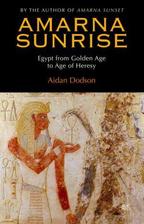
Amarna Sunrise:
Egypt from Golden Age to Age of Heresy
(Hardcover, 2014)
By Aidan Dodson
Egypt from Golden Age to Age of Heresy
(Hardcover, 2014)
By Aidan Dodson
The latter part of the fifteenth century BC saw Egypt's political power reach its zenith, with an empire that stretched from beyond the Euphrates in the north to much of what is now Sudan in the south. The wealth that flowed into Egypt allowed its kings to commission some of the most stupendous temples of all time, some of the greatest dedicated to Amun-Re, King of the Gods. Yet a century later these temples lay derelict, the god's images, names, and titles all erased in an orgy of iconoclasm by Akhenaten, the devotee of a single sun-god. This book traces the history of Egypt from the death of the great warrior-king Thutmose III to the high point of Akhenaten's reign, when the known world brought gifts to his newly-built capital city of Amarna, in particular looking at the way in which the cult of the sun became increasingly important to even 'orthodox' kings, culminating in the transformation of Akhenaten's father, Amenhotep III, into a solar deity in his own right.
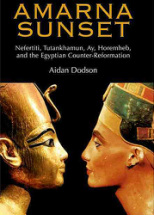
Amarna Sunset: Nefertiti, Tutankhamun, Ay, Horemheb, and the Egyptian Counter-Reformation
(Hardcover, 2009)
By Aidan Dodson
(Hardcover, 2009)
By Aidan Dodson
This new study, drawing on the latest research, tells the story of the decline and fall of the pharaoh Akhenaten's religious revolution in the fourteenth century BC. Beginning at the regime's high-point in his Year 12, it traces the subsequent collapse that saw the deaths of many of the king's loved ones, his attempts to guarantee the revolution through co-rulers, and the last frenzied assault on the god Amun.
The book then outlines the events of the subsequent five decades that saw the extinction of the royal line, an attempt to place a foreigner on Egypt's throne, and the accession of three army officers in turn. Among its conclusions are that the mother of Tutankhamun was none other than Nefertiti, and that the queen was joint-pharaoh in turn with both her husband Akhenaten and her son. As such, she was herself instrumental in beginning the return to orthodoxy, undoing her erstwhile husband's life-work before her own mysterious disappearance.
The book then outlines the events of the subsequent five decades that saw the extinction of the royal line, an attempt to place a foreigner on Egypt's throne, and the accession of three army officers in turn. Among its conclusions are that the mother of Tutankhamun was none other than Nefertiti, and that the queen was joint-pharaoh in turn with both her husband Akhenaten and her son. As such, she was herself instrumental in beginning the return to orthodoxy, undoing her erstwhile husband's life-work before her own mysterious disappearance.
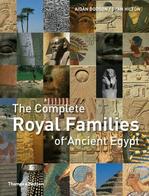
The Complete Royal Families of Ancient Egypt
(Paperback, 2010)
By Aidan Dodson and Dyan Hilton
(Paperback, 2010)
By Aidan Dodson and Dyan Hilton
Bonus: this book also personally signed by co-author Dyan Hilton!
This groundbreaking book illuminates the lives of some 1,300 kings, queens, princes, and princesses of ancient Egypt, unraveling family relationships and exploring the parts they played in politics, cultural life, and religion.
The authors begin with a basic summary of the structure of the pharaonic state, including the nature of ancient Egyptian kingship itself, and then introduce key members of the royal family. This is followed by a chronological survey of the royal family from c. 3100 BC to the last Cleopatra. For each dynasty, or significant part of a dynasty, the authors provide an historical overview of the period, a summary listing of the kings, and a discussion of their families’ relationships.
This superb biographical history of ancient Egypt is handsomely illustrated with hundreds of photographs, line drawings, and genealogical trees. 90 color and 210+ black-and-white illustrations
This groundbreaking book illuminates the lives of some 1,300 kings, queens, princes, and princesses of ancient Egypt, unraveling family relationships and exploring the parts they played in politics, cultural life, and religion.
The authors begin with a basic summary of the structure of the pharaonic state, including the nature of ancient Egyptian kingship itself, and then introduce key members of the royal family. This is followed by a chronological survey of the royal family from c. 3100 BC to the last Cleopatra. For each dynasty, or significant part of a dynasty, the authors provide an historical overview of the period, a summary listing of the kings, and a discussion of their families’ relationships.
This superb biographical history of ancient Egypt is handsomely illustrated with hundreds of photographs, line drawings, and genealogical trees. 90 color and 210+ black-and-white illustrations
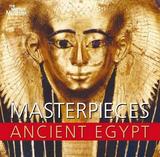
Masterpieces of Ancient Egypt
(Paperback, 2012)
by Nigel Strudwick
(Paperback, 2012)
by Nigel Strudwick
The British Museum has the largest and finest collection of antiquities from Egypt and the Sudan outside of those countries. Masterpieces of Ancient Egypt presents the highlights of the British Museum's Egyptian collection for the first time in print. This beautiful volume displays 200 of the most important and famous objects, including the Rosetta Stone, as well as a selection of lesser-known but equally significant pieces. Together, these works offer an overview of the whole of ancient Egyptian art.
Each object is illustrated with a full-page color photograph, many of which were taken especially for this publication. The accompanying text unfolds the story and features of each object. The introduction offers a brief history of the vast collections of the Department of Ancient Egypt and Sudan and a description of how and why items are selected for display in the permanent galleries of the British Museum.
Each object is illustrated with a full-page color photograph, many of which were taken especially for this publication. The accompanying text unfolds the story and features of each object. The introduction offers a brief history of the vast collections of the Department of Ancient Egypt and Sudan and a description of how and why items are selected for display in the permanent galleries of the British Museum.
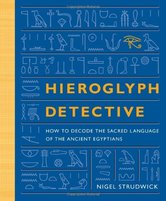
Hieroglyph Detective: How to Decode the Sacred Language of the Ancient Egyptians
(Paperback, 2010)
by Nigel Strudwick
(Paperback, 2010)
by Nigel Strudwick
Egyptian hieroglyphs have long fascinated people the world over, though traditionally only specially trained scholars have been able to unlock their esoteric secrets. In Hieroglyph Detective, renowned Egyptologist Nigel Strudwick offers a historical background for the symbols as he takes the reader on a visual tour of museums around the world and provides step-by-step instructions on how to decipher inscriptions from ancient Egyptian tombs and temples. This hands-on field guide contains everything one needs to uncover age-old mysteries like a true detective!
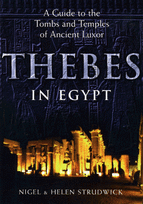
Thebes in Egypt:
A Guide to the Tombs and Temples of Ancient Luxor
(Paperback, 1999)
by Nigel Strudwick and Helen Strudwick
A Guide to the Tombs and Temples of Ancient Luxor
(Paperback, 1999)
by Nigel Strudwick and Helen Strudwick
The remains of ancient Thebes constitute one of the largest and most remarkable archaeological sites in all of Egypt and indeed the world. The discoveries made at this site, now the modern town of Luxor, are responsible for much of our knowledge of ancient Egyptian civilization. After excavating and researching the city of Thebes for many years, Nigel and Helen Strudwick here offer the first comprehensive introduction to it, one that will be welcomed by both armchair travelers and visitors to that popular tourist destination. Handsomely illustrated, the book features eighty photographs—thirty in color—and twenty maps and plans.After reviewing the topography of the site, the Strudwicks recount the history of Thebes from the city's rise in the late Old Kingdom to the peak of its power in the New Kingdom and to its gradual decline in the Greco-Roman period. They discuss the central role played by the gods in the community's religious life, and take us on a tour of the great temples of Karnak and Luxor on the East Bank of the Nile and of the temples and tombs of kings, queens, princes, and ordinary individuals on the West Bank.Drawing on their intimate acquaintance with ancient Egyptian society, the authors re-create the lives of Thebans during the New Kingdom. They conclude by assessing Greek, Roman, Coptic, and Islamic influences on the area as it exists today and by providing an overview of the archaeological research undertaken there.